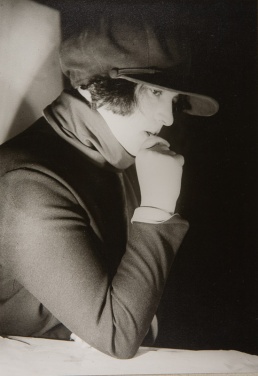Esfir Shub
 Esfir Shub in Soviet Screen 27 (July 1927). |

Esfir Shub (Эсфирь Ильинична Шуб, 1894–1959) was a pioneering Soviet filmmaker and editor in both the mainstream and documentary fields. She is best known for her trilogy of films, Fall of the Romanov Dynasty (1927), The Great Road (1927), and the Russia of Nicholas II and Leo Tolstoy (1928).
Esfir Shub like Dziga Vertov and Yelizaveta Svilova developed a documentary montage film style using already existing documentary material from pre-revolutionary, tsarist times that she researched to be combined with new shots. The material was put in context through montage and inter-titles. The Fall of the Romanov Dynasty was made in 1927 on occasion of the 10th anniversary of the October Revolution. Shub became a central figure of the Soviet documentary cinema, working at the Sovkino studios since 1926 and as film director at the Central Documentary Studio from 1942-1953. [1]
Sergei Emolinsky, a constructivist critic associated with Soviet art journal, LEF, praised both Shub and Vertov equally for their different attitudes towards documentary film. He explained that while, “Vertov ‘threw himself on the given material, cutting it into numerous pieces, thus subordinating it to his imagination [..] Shub regarded each piece [shot] as to a self-sufficient, autonomous entity’.” This first-hand critique of the two methods indicate that Shub’s dedication to journalistic cinematography was the catalyst for what documentary film classifies today, compilation film. [2]
Shub was married to Aleksei Gan.
Filmography
- The Fall of the Romanov Dynasty, dir. Esfir Schub, 1927.
- Prostitutka, dir. Oleg Frelikh, ed. Esfir Shub, 77 min, 1927.
- The Great Road, 1927.
- The Russia of Nicholas II and Lev Tolstoi, 1928.
- Today, 1930.
- Komsomol: Patron of Electrification [Комсомол - шеф электрификации], dir. Esfir Shub, 1932. [3] [4]
- Spain [Испания], 1939. [5]
- The Native Country [Страна Родная], 1942. [6]
- On the Other Side of the Araks, 1946.
Literature
- A.Konopleva-Shub (А.Б.Коноплева), "Алексей Михайлович Ган" [Alexei Mikhailovich Gan], Kinovedcheskie zapiski [Киноведческие записки] 49 (2000), Moscow, pp 212-221. Memoirs of Esfir Shub’s daughter about her step-father. (Russian)
- "'...Болезнь моя иного порядка'. Письма Алексея Гана Эсфири Шуб" ['...My ilness is of another mode'. Letters from Alexei Gan to Esfir Shub], Kinovedcheskie zapiski 49 [Киноведческие записки] (2000), Moscow, pp 222-228. Gan's letter to Esfir Shub, disclosing their differences concerning development of domestic cinema of the 1920s and presenting hard attempts at self identification of one of the founders of Constuctivism under post-revolutionary regime. [7] (Russian)
- "Письмо Эсфири Шуб Алексею Гану" [A letter from Esfir Shub to Alexei Gan], Kinovedcheskie zapiski 49 [Киноведческие записки] (2000), Moscow, pp 229-230. The last letter from Esfir Shub to Alexei Gan. [8] (Russian)
- Joshua Malitsky, "A Certain Explicitness: Objectivity, History, and the Documentary Self", Cinema Journal 50:3 (Spring 2011), pp 26-44; new version as "Esfir Shub, Factography, and the New Documentary Historiography", ch. 5 in Malitsky, Post-Revolution Nonfiction Film: Building the Soviet and Cuban Nations, Indiana University Press, 2013. [9] (English)
- Joshua Malitsky, "Ideologies in Fact: Still and Moving-Image Documentary in the Soviet Union, 1927-1932", Journal of Linguistic Anthropology 20:2 (2010), pp 352-371. (English)
- More